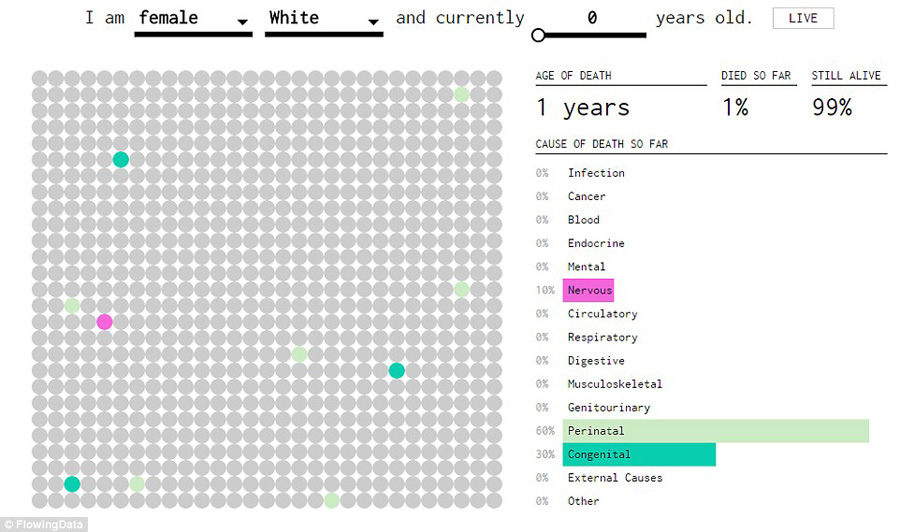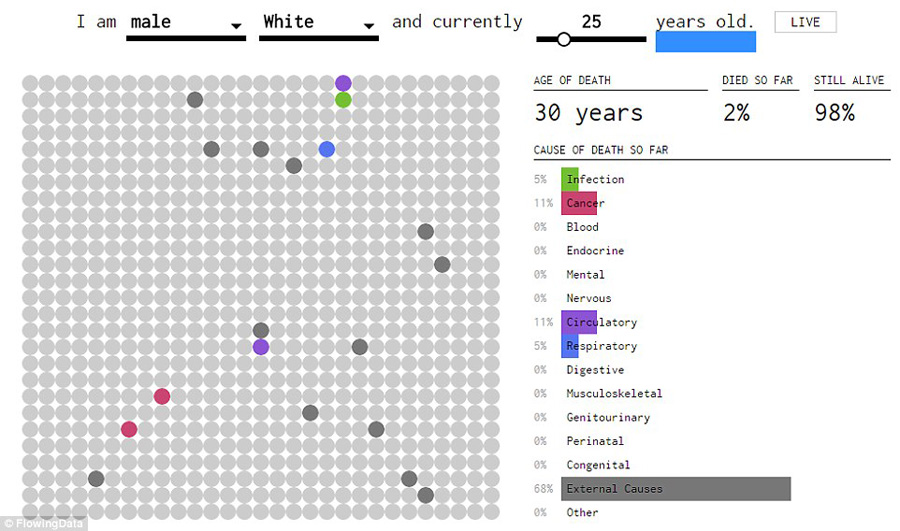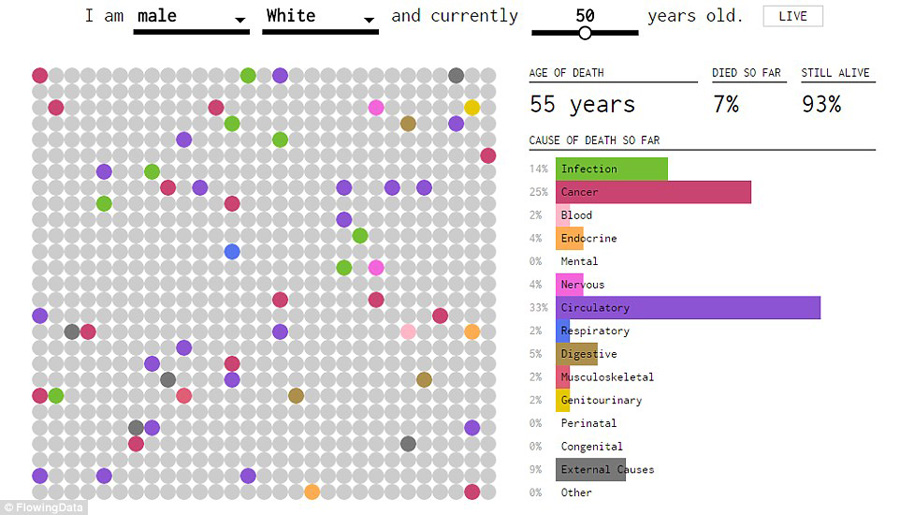

It's often been quoted as the one certainty in life - and now it's possible to find out exactly how you're likely to die.
An interactive chart has been created which calculates the likelihood of a person dying from the likes of cancer, infection or external causes based both on a person's current age and how old they are when they go.
Using information from the Centers for Disease Control and Prevention, UCLA statistician Nathan Yau has created the colourful graphic revealing what you are most likely to die from once factors such as gender and race have been considered.
The test, which can be taken by clicking here, works by asking users to enter details including age, gender, and ethnicity before they can watch how their life and death may unfold.
It shows how the age you are today can affect what you are most likely to die of at various stages in your life.
So while a baby born today is most likely to die in the first few years of life from a congenital problem, a man who is 30 today who dies at the age of 80 is most likely to be killed by a circulatory problem - such as a heart attack or stroke - or by cancer.

30-year-old women, who die in 50 years time aged 80, can expect to succumb to similar causes with circulatory at 39 per cent and cancer, 29 per cent, compared to lesser causes such as infection at five per cent.
Writing on his Flowing Data website, Professor Yau explains how the different dots relate to the various causes of death, listed right.
'Colour corresponds to cause of death, and the bars on the right keep track of the cumulative percentages. By the end, you're left with the chances that you will die of each cause,' he writes.
By changing the age, the number of dots changes with a much lower mortality rate among children leading to fewer colourful circles.
For example, the leading causes of death in someone who is less than 12 months old are perinatal or congenital i.e. a condition inherited from birth.
However, this compares to circulatory problems, such as heart disease and stroke, being the most likely cause of death for both men and woman in their 50s.
The infographic, based on data from US death certificates between 1999 and 2014, shows how an-eight-year-old boy is most likely to be killed by an 'external factor,' such as an accident, if they die at the age 18.
The chart calculates this cause to be behind 67 per cent of deaths in these circumstances, compared to respiratory causes like asthma coming in at 17 per cent.
The older people get, the more likely they are to die from disease with anyone over the age of 80 having a 40 per cent or higher change of dying from a circulatory problem, regardless of the demographic.
'This surprised me, because it seems like cancer would be the leading cause just going off general news, said Professor Yau.
'This is certainly true up to a certain age, but get past that and your heart can only keep going for so long,' he said.
Across the globe, heart disease and stroke are the leading causes of death, accounting for 31 per cent of the total figure, according to the American Heart Association.

The coloured dots show that a female born now who dies at the age of one is most likely to succumb to a perinatal cause, which is behind 60 per cent of deaths, a congenital cause, at 30 per cent and the nervous category making up the remaining 10 per cent.

Interestingly, a 25-year-old man who dies at 30 is far more likely to die of an external cause (68 per cent) - like a car crash - than cancer (11 per cent) or an infection (five per cent)
Figures issued by the World Health Organisation for 2012 revealed that 68 per cent of all deaths globally were from what are known as noncommunicable - rather than infectious diseases.
The main four noncommunicable diseases are cardiovascular diseases (such as heart disease and stroke), cancers, diabetes and chronic lung diseases.
Infectious diseases, pregnancy and childbirth and nutrition conditions collectively were responsible for 23 per cent of global deaths, while injuries caused 9 per cent of all deaths
Deaths from often preventable causes - such as heart disease, cancer, diabetes and lung conditions - were most common in high-income countries, where they accounted for 87 per cent.
Tobacco use is a major cause of many of the world’s top killer diseases – including cardiovascular disease, chronic obstructive lung disease and lung cancer.
The World Health Organisation estimates that tobacco use is responsible for the death of about 1 in 10 adults worldwide. Smoking is often the hidden cause of the disease recorded as responsible for death.

If a 50-year-old man died in five years time, he could expect it to be caused by any of the above but circulatory problems and cancer remain the leading reasons, accounting for more than half of deaths between them.

If a white female who is 50 now dies at the average age of 88, she will probably die of either circulatory causes or cancer, the chart shows.
Day|Week

 Chinese pole dancing master opens class in Tianjin
Chinese pole dancing master opens class in Tianjin The most beautiful town of snow in China
The most beautiful town of snow in China SWAT members hold romantic wedding in E China
SWAT members hold romantic wedding in E China Breathtaking scenery and simple lifestyle in Hainan
Breathtaking scenery and simple lifestyle in Hainan Finding sexiest underwear supermodels
Finding sexiest underwear supermodels Top 10 ancient pagodas in China
Top 10 ancient pagodas in China Chinese version of Victoria's Secret Show held in Hunan
Chinese version of Victoria's Secret Show held in Hunan Can you find out the sniper hiding in camouflage?
Can you find out the sniper hiding in camouflage? Spectacular rockets launch scenes
Spectacular rockets launch scenes Spectacular aerial photos of the Three Gorges
Spectacular aerial photos of the Three Gorges